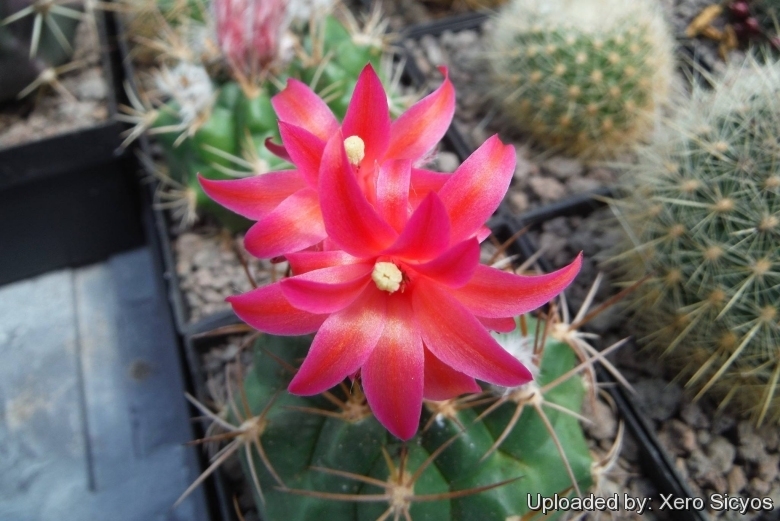Accepted Scientific Name: Matucana paucicostata F.Ritter
Taxon 12: 124. 1963

Matucana caespitosa Photo by: Xero Sicyos
Synonyms:
See all synonyms of Matucana paucicostata
Description: Matucana caespitosaSN|6059]]SN|19044]] n.n. is an undescribed name used commercially to indicate one of the local forms of Matucana paucicostata, which is a sparse ribbed globular cactus often branching basally to form small clusters. It is one of the smallest matucana species. Friedrich Ritter found this type in 1956, and spread it under no. FR 597. Commercially the type has emerged as Matucana / Submatucana caespitosaSN|31739]]SN|31739]] nn or Matucana spec. nov. FR597.
Remarks: Matucana paucicostataSN|19044]]SN|6059]] is a relatively variable species that has received an undue number of names. The differences usually concern only the spination, however the colouring, size and density of spines is greatly influenced by the conditions of culture, at lower light levels the spines are less numerous, delicate and paler, while with strong solar radiation the spines are stronger with a darker tint. Minor differences can also be found in the colour of flowers sometime with a more orange or purple tint.
Subspecies, varieties, forms and cultivars of plants belonging to the Matucana paucicostata group
 Matucana caespitosa n.n.: is an undescribed name used commercially to indicate one of the local forms of Matucana paucicostata (same as the type). Distribution: Rio Huari, Peruvian region of Ancash.
Matucana caespitosa n.n.: is an undescribed name used commercially to indicate one of the local forms of Matucana paucicostata (same as the type). Distribution: Rio Huari, Peruvian region of Ancash. Matucana paucicostata F.Ritter: has globular stems branching basally. Flowers purplish pink to carmine red long-necked, slightly zygomorphic. Distribution: Rio Puchca, Rio Mosna, Rio Huari, and Maranon, Peruvian region of Ancash.
Matucana paucicostata F.Ritter: has globular stems branching basally. Flowers purplish pink to carmine red long-necked, slightly zygomorphic. Distribution: Rio Puchca, Rio Mosna, Rio Huari, and Maranon, Peruvian region of Ancash.
Bibliography: Major references and further lectures
1) Kakteen und andere Sukkulenten, Volume 38 Steinhart KG, 1987
Edward F. Anderson “The Cactus Family” Timber Press, 2001
3) David Hunt, Nigel Taylor “The New Cactus Lexicon” DH Books, 2006
5) Walther Haage “Kakteen von A bis Z”+ Neumann Verlag, 1981
6) James Cullen, Sabina G. Knees, H. Suzanne Cubey “The European Garden Flora Flowering Plants: A Manual for the Identification of Plants Cultivated in Europe, Both Out-of-Doors and Under Glass” Cambridge University Press, 11/Aug/2011
Cultivation and Propagation: Matucana caespitosaSN|19044]]SN|19044]] is an easy to grow ornamental species suited for any well drained soil in half or full sun.
Growth rate: It is a small growing species, but it it possible to increase the speed of growth to some extent by providing adequate amount of water, warmth, and fertilizer during the active growing season, but it’s susceptible to rotting if too wet and do not like a lot of water when it is on rest.
Soil and pots: It likes deep pot with generous drain holes to accommodate its tap root, needs a very airy potting medium very permeable to water which mainly consists of non organic material such us clay, pumice, lava grit, expanded slate and only a little peat or leaf-mould, slightly acid, pH-value between 4,5–6. Re-pot every two years.
Fertilization: Need a perfect fertilizer diet in summer. Use preferably a cacti and succulents fertilizer with high potassium content including all micro nutrients and trace elements or slow release fertilizer.
Exposure: This plant need full sun but tolerate moderate shade, and a plant that has been growing in shade should be slowly hardened off before placing it in full sun as the plant will be severely scorched if moved too suddenly from shade into sun.
Watering: No water should ever be allowed to stand around the roots. Keep almost completely dry in winter. However this spurge will tolerate dryness and can even thrives in poor, dry soils, but do better when grown in nutrient-rich soils with regular watering.
Hardiness: Tender. This cactus cannot tolerate any frost and can be difficult to get it to look its best without a good amount of heat. It can be grown outdoors in frost-free climates.
Rot: Rot it is only a minor problem with cacti if the plants are watered and “aired” correctly. If they are not, fungicides won't help all that much.
Propagation: The plant can be reproduced by seeds or cuttings. If you remove an offset, remember to let it dry for some days, letting the wound heal (cuttings planted too soon easily rot before they can grow roots). Lay it on the soil and insert the stem end partially into the substrate. Try to keep the cutting somewhat upright so that the roots are able to grow downward.










